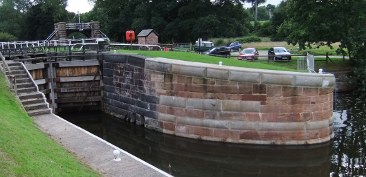MANY boaters are confused by the ongoing restrictions through Royal Vale Lock on the Weaver, which is a complete shambles.
It was way back in 2003 that the problem started when the lower bull nosed wall suffered a collapse on the small lock, so the large lock had to be used instead, bringing in restrictions due to the amount of water it required. Then in September last year British Waterways announced it was spending a massive £2.5 millions in repairs.
Restrictions still in force
It was boater Roger Olver who reported problems at the lock last October, telling that the work was well in progress, and was surprised to see that timing restrictions were still in force when he once again cruised the river, with only the large lock in operation telling us:
"While descending the Anderton Boat Lift on to the River Weaver and reading the 2010 Weaver Navigation Guide we found it a little disturbing that almost 12 months on, Vale Royal Locks still had timed passages (no mention of this in the latest pdf Boaters Guide downloaded from Waterscape).The work was well on last October so why would they be still timing passage to conserve water in the big lock? Surely by now the smaller lock would be back in service.
"Arriving at the lock and informing the locky we were on the holding pontoon, we could see we were still to be using the main lock chamber. The smaller lock has no construction fencing around it, no sign of work going on anywhere in fact. The lock chamber is in water but half of it is covered in duck weed."

English Heritage
He learnt that the project to repair the bull nose wall of the smaller lock was finally to go ahead with some funding in place from Defra, but tells us that in stepped the English Heritage bods, sniffing there was money to be squandered, and of course British Waterways fell all over themselves to agree with them. Presumably a listed structure, the project now had to be completed in such a way that it mimicked exactly the original specification, Roger explaining:
"So a relatively cheap and simple concrete repair was out and mind-boggling expensive original stonework reconstruction took place. Admittedly the completed works look great but it has to be asked, can the network afford such niceties with ever reducing budgets?
"The cost of the repairs is a staggering £3,200,000. That in itself seems quite obscene, but when you are then told that the lock is still inoperable, it really is beyond belief!"
 The problem is the pedestrian swing bridge which is obviously a public right of way and must be maintained, but has been inoperable and beyond repair since 2003! Until the bridge can be replaced the lock will remain inoperative.
The problem is the pedestrian swing bridge which is obviously a public right of way and must be maintained, but has been inoperable and beyond repair since 2003! Until the bridge can be replaced the lock will remain inoperative.
Ignored local managers
Apparently the consultants overseeing the project on behalf of British Waterways chose to ignore local managers, the long standing problems with the bridge and the consequences of not replacing it at the same time.
As a possible solution Roger tells us:
"We learned that there is a plan to bring the floating crane back to site (not a cheap exercise), lift the offending bridge into the open position and build a temporary scaffolding pedestrian bridge beyond the lower lock gates to enable passage to be resumed, and to save some of the red faces of the British Waterways managers. This temporary solution will be at a truly tremendous cost of course and no doubt with more fees from the 'consultants'.
